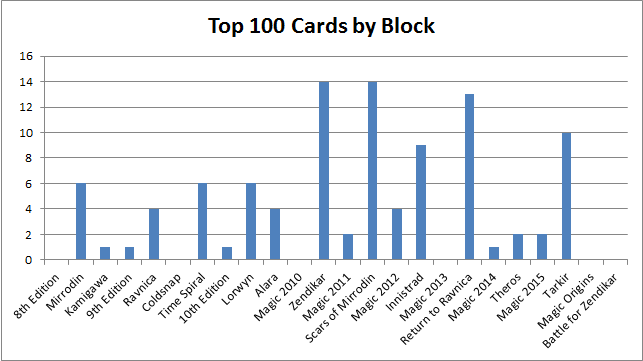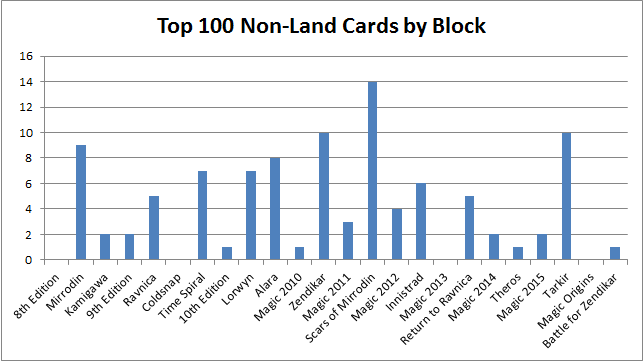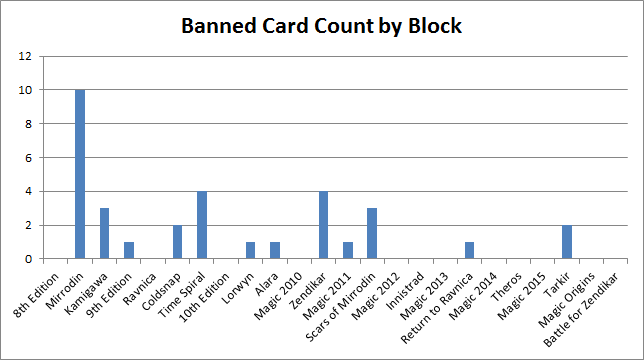The Modern format was created almost five years ago, in May of 2011. At the time the format stretched back to 2003 with the release of the modern card-frame in 8th edition. Eight years of expansions has now grown to 13 years of expansions, a 63% increase. The original banned list included 21 cards which has now grown to 34 cards, a 62% increase. As the format continues to grow, the banned list will keep pace. But is this a sustainable format? What would come next? After all, Modern replaced Extended, so does it make sense that one day something may replace Modern?
Post-Modern Magic
Modern is young as formats go, but old enough to have a very large body of work to be analyzed. There are now 50 expansions that are legal in Modern including core sets. There were 35 expansions before the modern frame was introduced in 8th edition. So the number of sets in Modern is now vastly larger than the number of sets not in Modern. Legacy and Vintage, therefore, consist of 85 expansions and core sets. This means that Modern currently encompasses 59% of the Legacy card-pool. In five years, with four expansions per year, that number will grow to 67%. In ten years it will be 72%. As time goes on the Modern format will become larger and larger and ultimately one has to wonder what the plan is to sustain such a format.
Should Modern have a smaller card pool? That’s an important question and one that is going to come up more and more often as time goes on and the format grows. If you search for “Modern” in Gatherer you get 9,679 results which is not a perfect way to determine how many cards are in Modern, but it’s close enough. Those cards are distributed across 13 years of expansions, but the cards played regularly don’t share an even distribution. Looking at all of the tournament results from 2015 we can see the top 100 cards played in Modern distributed across expansions. For the sake of our interest I’ve counted cards against the latest expansion available. So the shock lands come from Return to Ravnica block instead of Ravnica block.
Even if we remove the lands from our analysis, which mostly cuts back Zendikar and Return to Ravnica, we still have a format whose card distribution is greatly concentrated in the middle of our timeline. Scars of Mirrodin block accounts for the most cards in both charts (tied with Zendikar in the first one) and that’s largely thanks to the power of Affinity. You may have noticed that other than the modern frame itself, 8th Edition actually contributes very little to the format. Summer Bloom also existed in 9th Edition as did Blood Moon.
The majority of influential cards in the Modern format can be found after Magic 2010. If we count lands, then 71 of the top 100 cards can be found in sets after Magic 2010. If we exclude lands that number drops to 59 but still presents a majority of the format. The banned list, however, does present most of its cards prior to Magic 2010.
Obviously the cycle of artifact lands skews things heavily towards Mirrodin block, but even without those five cards Mirrodin would still lead the format in banned cards thanks to [casthaven]Chrome Mox[/casthaven], [casthaven]Cloudpost[/casthaven], [casthaven]Second Sunrise[/casthaven], [casthaven]Seething Song[/casthaven], and [casthaven]Skullclamp[/casthaven]. After Magic 2010, only 11 cards have been banned, and only three of them come after Magic 2013.
Getting back to the topic of sustainability of the Modern format, is it possible that roughly 10,000 cards is simply too big to reign in the format? Legacy, after all, is roughly 15,000 cards, and features a lot of Modern staples anyways. It’s no secret that there are problems with the Modern format which results in Wizards taking drastic measures to keep the Pro Tour exciting.
Wizards wants to support Modern. The question is, can they do that with the ever-growing card pool and not upset their customers? What are their alternatives?
Option 1 – Make Modern Rotate Annually
With two blocks each year, is it time to put a cap on the Modern card count and start rotating the format? Let’s say that Wizards announces that with the release of the 2016 Fall Block (in October) that Modern will rotate for the first time. Four expansions will be removed from Modern including 8th Edition, Mirrodin, Darksteel, and Fifth Dawn. Moving forwards, each year another year’s worth of expansions will rotate out of the format. When the 2017 Fall Block releases, all three sets of the Kamigawa Block along with 9th Edition will rotate out of Modern.
Obviously this would be a drastic change to the format which has always been billed as non-rotating. Removing Mirrodin would result in the loss of six of the top-played cards in the format, nine of the top-played non-land cards, and ten of the format’s banned cards. That’s a significant change though most of it revolves around the loss of Affinity as a deck. Could Affinity survive without Arcbound Ravager and Cranial Plating? It’s entirely possible. Many of the deck’s cards also come from Scars of Mirrodin block.
Losing 9th Edition would also have a huge impact. Even though they’re not among the top 100 cards in the format (which I found surprising) the Urza lands and Blood Moon would leave the format together if 9th Edition rotated out. That spells the end of ‘Tron decks. Under this proposal, in two years time we would see the removal of two of the top tier decks in the format.
In case you haven’t noticed, that’s already what’s happened in the past two years of Modern with the loss of [casthaven]Birthing Pod[/casthaven] and [casthaven]Splinter Twin[/casthaven]. If the format rotated, instead of relying on bannings, then players would at the very least be well-informed of what was coming in the next year instead of having to wait for the B&R announcement prior to the Pro Tour.
The biggest downside to rotating the format is cards losing value. Affinity is not a top deck in Legacy, though it sees some play. The upside however would be trying to mitigate the [casthaven]Sudden Impact[/casthaven] that Wizards creates by banning the format’s most popular deck on a yearly basis.
Option 2 – Make Modern Rotate Every 5 Years
This is a more drastic option. Instead of rotating every year, which creates a constant instability of sorts, we can rotate the format periodically, creating large periods of stability and a slow build-up towards a massive [casthaven]Upheaval[/casthaven] of the format. When Modern was formed the format had eight years of expansions. Now, five years later, what would happen if we cut back to eight years again? Currently Modern begins in July of 2003 with 8th Edition. If we move that up to July of 2008 and begin with Shards of Alara in October 2008 then we would be losing 8th Edition, Mirrodin Block, Kamigawa Block, 9th Edition, Ravnica Block, Coldsnap, Time Spiral Block, 10th Edition, and Lorwyn/Shadowmoor Block. Modern would be a completely different format, reset to the beginning of Alara Block. This actually lines up, roughly speaking, with the creation of New World Order, so maybe we could call this New World Modern, at least until it rotates again in 2021.
Option 3 – Bring Back Extended
If you don’t like the idea of giving up Modern as it exists today, and I can’t blame you because I’m still not convinced we need a change, then maybe what we really need is a new format to bridge the gap between Standard and Modern. A format that could be highlighted on the Pro Tour and at PPTQ’s and Grand Prixs without ruining the stability of a non-rotating format like Modern. Maybe we should bring back Extended.
The problem with Extended, which was replaced with Modern, was that it ultimately looked like Standard from a few years prior. People were sick of rehashing Standard, so we got rid of Extended. Would the same problem still exist? A four-year rotating format would begin with Magic 2013. Would it be dominated by Return to Ravnica and Theros? I highly doubt it. It’s possible such a format would look more like a hyper-charged Standard than a replay of Standard circa 2013.
Is that a good thing? It’s probably good for the Pro Tour to have a non-Standard format that can highlight cards from the new expansions. It’s probably good to have a format that helps collectors maintain the value of their Standard cards post rotation. But, it would clearly take a large chunk out of Modern’s player-base. Could Wizards support both Extended and Modern? I have doubts, since they can barely support Modern properly.
What To Do?
In the end it comes down to how well Wizards can support a format. They’ve thrown considerable effort behind Modern in the past half-decade and what do we have to show for it? A format that can barely handle being featured on the Pro Tour. A format with a financial barrier for entry that continues to grow closer and closer to Legacy. A format with a meta-game that fosters more variance than skill. Is this the format Wizards should keep supporting?
I wish I could answer that question. After considering the three options above, and many more I didn’t share, the root of the problem becomes apparent to me. The problem isn’t Modern itself, it’s Wizards ability to properly support Modern as a format. As an idea Modern has a lot going for it. But in practice Wizards is constantly struggling to meet the demands of their own creation. If Wizards could better support a rotating Modern format, or a new Extended format, would it be better for the community? I don’t know, but I sure as hell hope someone at Wizards is giving this serious thought.
Because, to be honest, if Wizards is going to ban the best deck every year, they should really stop calling Modern a non-rotating format.
What We Learned is a weekly feature here at Hipsters of the Coast written by former amateur Magic Player Rich Stein, who came really close to making day two of a Grand Prix on several occasions. Each week we will take a look at the past seven days of major events, big news items, and community happenings so that you can keep up-to-date on all the latest and greatest Magic: the Gathering community news.




